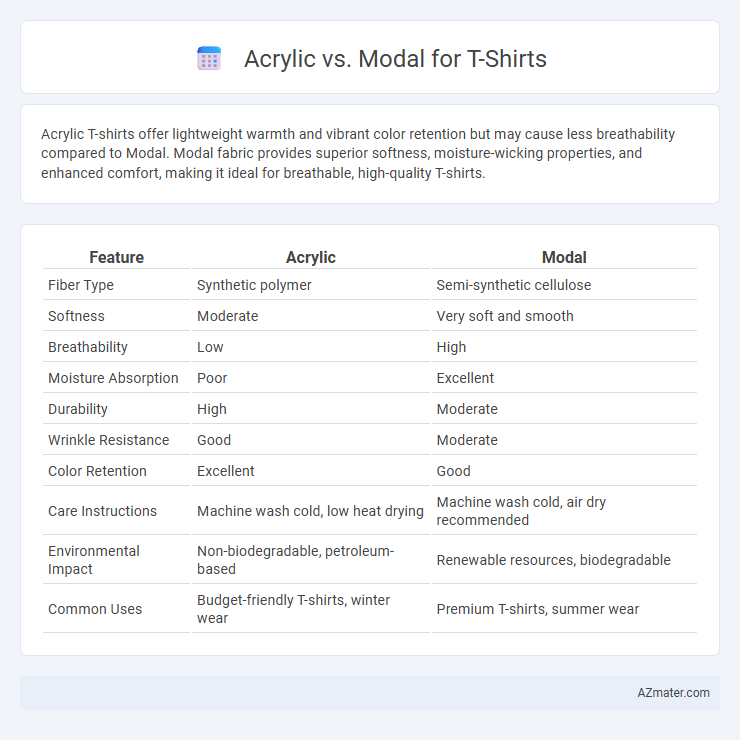Acrylic T-shirts offer lightweight warmth and vibrant color retention but may cause less breathability compared to Modal. Modal fabric provides superior softness, moisture-wicking properties, and enhanced comfort, making it ideal for breathable, high-quality T-shirts.
Table of Comparison
| Feature | Acrylic | Modal |
|---|---|---|
| Fiber Type | Synthetic polymer | Semi-synthetic cellulose |
| Softness | Moderate | Very soft and smooth |
| Breathability | Low | High |
| Moisture Absorption | Poor | Excellent |
| Durability | High | Moderate |
| Wrinkle Resistance | Good | Moderate |
| Color Retention | Excellent | Good |
| Care Instructions | Machine wash cold, low heat drying | Machine wash cold, air dry recommended |
| Environmental Impact | Non-biodegradable, petroleum-based | Renewable resources, biodegradable |
| Common Uses | Budget-friendly T-shirts, winter wear | Premium T-shirts, summer wear |
Introduction to Acrylic and Modal Fabrics
Acrylic fabric is a synthetic fiber known for its lightweight, soft texture, and resistance to wrinkles and mildew, making it a popular choice for affordable, durable T-shirts. Modal fabric, derived from beech tree pulp, offers exceptional breathability, moisture-wicking properties, and a smooth, silky feel that enhances comfort and drape in T-shirts. Both fabrics cater to different preferences, with acrylic excelling in durability and modal providing superior softness and environmental sustainability.
What is Acrylic? Properties and Uses
Acrylic is a synthetic fiber made from polymerized acrylonitrile, known for its lightweight, soft, and wool-like texture. Its key properties include excellent moisture-wicking, colorfastness, and resistance to wrinkles, making it a popular choice for affordable and durable clothing like T-shirts. Acrylic fibers are commonly used in the apparel industry for knitwear, activewear, and outdoor garments due to their warmth retention and quick-drying capabilities.
What is Modal? Properties and Uses
Modal is a semi-synthetic fabric made from beech tree pulp, known for its exceptional softness, breathability, and moisture-wicking properties, making it ideal for t-shirts. It offers higher durability and greater resistance to shrinking and pilling compared to acrylic, ensuring long-lasting comfort and shape retention. Commonly used in activewear and casual clothing, modal provides a lightweight, smooth texture that enhances wearability and reduces skin irritation.
Comfort and Feel: Acrylic vs Modal
Modal fabric offers superior softness and a smooth texture, making it highly comfortable against the skin compared to acrylic. Acrylic tends to feel slightly rougher and less breathable, which can lead to discomfort during extended wear. Modal's moisture-wicking properties enhance comfort by keeping the skin dry, while acrylic often retains heat and moisture.
Breathability and Moisture Wicking
Modal offers superior breathability and moisture-wicking properties compared to acrylic, making it ideal for T-shirts worn in warm or active conditions. Acrylic fibers tend to trap heat and moisture, leading to less comfort during prolonged wear. Modal's natural cellulose base enhances airflow and efficiently draws sweat away from the skin, promoting a cooler, dryer experience.
Durability and Longevity Comparison
Acrylic fibers offer high durability with excellent resistance to wear, fading, and shrinkage, making them suitable for long-lasting T-shirts. Modal, a type of rayon made from beech tree pulp, provides moderate durability while excelling in softness and moisture-wicking but tends to weaken with repeated washing. For T-shirts requiring superior longevity, acrylic blends typically outperform modal in retaining shape and color over time.
Color Retention and Appearance
Modal fibers exhibit superior color retention compared to acrylic, maintaining vibrant hues even after multiple washes due to their high moisture absorbency that allows dye to penetrate deeply. Acrylic, while less breathable, offers bright colors initially but tends to fade and develop a dull appearance over time with exposure to sunlight and repeated laundering. Modal's smooth, silky texture enhances the T-shirt's overall appearance, providing a soft, lustrous finish that Acrylic cannot match.
Environmental Impact and Sustainability
Modal fabric, derived from renewable beech tree pulp, offers a more sustainable choice for T-shirts due to its biodegradable properties and lower environmental footprint compared to acrylic, a synthetic fiber made from petroleum-based chemicals. Acrylic production involves significant energy consumption and releases harmful emissions, contributing to pollution and non-biodegradable waste in landfills. Choosing modal over acrylic supports eco-friendly fashion by reducing dependency on fossil fuels and minimizing microplastic pollution in aquatic ecosystems.
Price Differences and Affordability
Acrylic t-shirts generally come at a lower price point compared to modal fabric due to acrylic's synthetic manufacturing process and lower raw material costs. Modal t-shirts, made from semi-synthetic fibers derived from beech trees, tend to be more expensive but offer superior softness and moisture-wicking properties. For budget-conscious buyers, acrylic tees provide an affordable option, though modal shirts deliver enhanced comfort and durability worth the higher investment.
Which Is Best for T-Shirts: Acrylic or Modal?
Modal fabric offers superior breathability, softness, and moisture-wicking properties, making it an ideal choice for comfortable, high-quality T-shirts. Acrylic, while durable and affordable, tends to retain heat and lacks the natural feel and breathability that modal provides. For T-shirts emphasizing comfort and performance, modal is generally the better option.

Infographic: Acrylic vs Modal for T-Shirt
 azmater.com
azmater.com